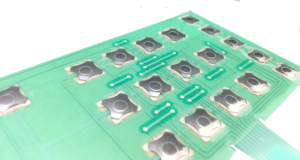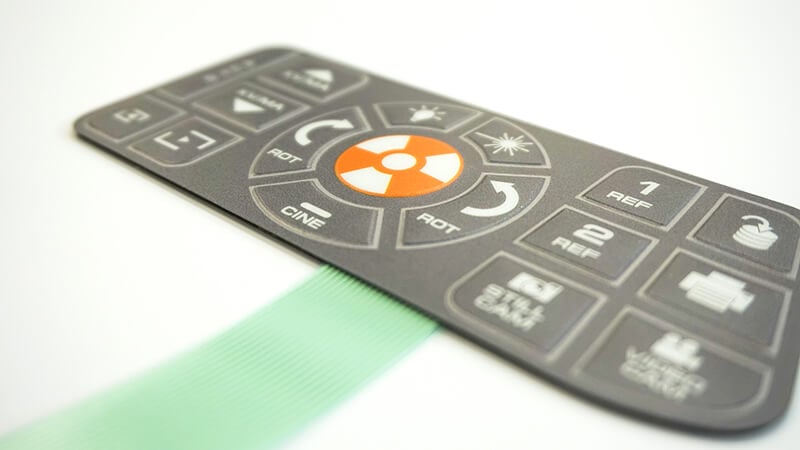Discover How a Membrane Switch Boosts Resilience and Functionality in Devices
Discover How a Membrane Switch Boosts Resilience and Functionality in Devices
Blog Article
Just How Membrane Layer Changes Contribute to the Longevity of Electronic Control Panels
Membrane layer buttons play a vital duty in enhancing the sturdiness of digital control panels, mostly with their multi-layered construction which gives efficient protection versus environmental factors such as dampness and dirt. This design not just reduces the risk of circuit damage and corrosion however additionally advertises convenience of upkeep because of its seamless surface. Moreover, the lack of moving parts considerably decreases the likelihood of mechanical failures, making membrane layer changes perfect for requiring applications. However, the implications of these attributes extend past simple defense, raising inquiries concerning their wider influence on performance and customer experience.
Definition of Membrane Layer Buttons

Membrane buttons are developed to be thin and light-weight, making them suitable for applications where area is restricted. They can be produced in numerous forms, sizes, and colors, providing versatility in layout that satisfies visual and functional needs. Additionally, membrane switches can integrate numerous innovations, such as responsive comments and LED indicators, enhancing individual experience.
Due to their building, membrane buttons are commonly immune to dust, dampness, and general wear, adding to their sturdiness sought after settings. Their seamless design not just promotes easy cleaning yet likewise decreases the danger of mechanical failing, making them a preferred choice for makers looking for trustworthy individual interfaces in their digital control board.
Security Versus Ecological Factors
The style of membrane layer switches naturally gives a degree of security versus various ecological aspects, which is important for keeping functionality in difficult conditions - Membrane Switch. These switches are typically constructed with layers of flexible products that secure inner parts from moisture, dirt, and pollutants. By encapsulating the circuitry, membrane layer switches over decrease the danger of short circuits and rust, which can significantly impair efficiency
Moreover, the use of durable adhesives and sealants during manufacturing enhances their resistance to ecological obstacles. Membrane buttons can endure exposure to chemicals and solvents, making them suitable for industries such as food processing and healthcare, where health and sanitation are vital. Their smooth surface style likewise prevents the buildup of dust and germs, helping with easier cleaning and upkeep.
Temperature changes are one more environmental concern, and membrane layer buttons are engineered to operate successfully throughout a variety of temperature levels you could try these out (Membrane Switch). This adaptability ensures that control panels continue to be operational in numerous settings, from industrial atmospheres to customer electronics
Influence On Customer Interaction
Individual communication with digital control board is considerably affected by the layout and functionality of membrane buttons. These buttons give a tactile user interface that boosts the overall customer experience, allowing for user-friendly navigation and control. Their receptive nature makes certain that individuals receive immediate feedback upon activation, which is essential for tasks needing precision and performance.
Additionally, the smooth surface area of membrane layer changes promotes simple cleansing and upkeep, advertising user confidence in the integrity of the interface. This cleanliness is specifically crucial in atmospheres where health is vital, such as medical or food processing settings. Additionally, the small and lightweight layout of membrane switches over adds to the aesthetic charm of control panels, motivating individual engagement through a contemporary and smooth appearance.
In addition, the assimilation of visual aspects, such as published symbols and backlighting, aids users promptly determine features, minimizing the learning contour associated with brand-new tools. Therefore, users can operate devices better, leading to boosted performance and fulfillment. In summary, membrane switches play a critical duty in boosting user interaction by integrating functionality, looks, and simplicity of usage, inevitably bring about improved functional performance.
Layout Versatility and Modification
Layout flexibility and customization are necessary aspects of membrane buttons, enabling manufacturers to tailor electronic control board to certain applications and customer demands. This adaptability enables the combination of various design components, such as shades, graphics, and textures, which can enhance the visual appeal and customer engagement of the control panel.
Membrane buttons can be personalized in shapes and size, accommodating a large range of tools and applications, from commercial machinery to customer electronics. This convenience look at this web-site guarantees that suppliers can create intuitive user interfaces that line up with customer expectations and functional needs. Furthermore, the ability to incorporate one-of-a-kind functions such as backlighting or tactile comments even more enhances use, allowing for a much more interactive experience.
Additionally, the production process for membrane layer switches over sustains the rapid prototyping of designs, making it possible for producers to repeat and refine their principles swiftly. This capability not just accelerates the growth timeline but also makes sure that the end product meets certain practical and aesthetic criteria.

Cost-Effectiveness and Longevity
Cost-effectiveness and durability are considerable advantages of membrane buttons, making them an appealing alternative for producers and end-users alike. These switches are commonly less costly to produce than standard mechanical switches, primarily because of their simplified manufacturing processes and the reduced number of elements required. This expense advantage prolongs not just to preliminary manufacturing yet additionally to lasting operational costs, as membrane layer switches often need less maintenance and have a reduced failing price.
In addition, the long life of membrane switches over adds to their total worth. Built from durable products, they are resistant to environmental factors such as moisture, dust, and chemicals, which can cause premature wear in various other button types. The absence of relocating components minimizes mechanical failure, permitting membrane switches to preserve functionality over prolonged durations.
This sturdiness is particularly beneficial in applications needing consistent efficiency under requiring conditions, such as clinical devices and commercial devices. Inevitably, the mix of cost-effectiveness and longevity makes membrane layer changes a financially sensible selection for manufacturers, offering dependable solutions that hold up against the examination of time while maximizing monetary factors to consider.
Final Thought
To conclude, membrane layer buttons dramatically improve the resilience of digital control panels via their robust building and safety features. By efficiently protecting circuitry from environmental hazards why not look here and decreasing the risk of mechanical failing, these switches make certain consistent performance popular applications. The smooth design promotes health and simplicity of upkeep, while customization options make it possible for tailored remedies for numerous requirements. In general, membrane layer changes represent a trustworthy and affordable choice for boosting the durability and performance of digital control systems.
Report this page